Alcyone Astronomical Software - ephemeris software, astronomical tables, solar eclipse calculator
Alcyone Astronomical Tables: List of Available Tables
Software > Alcyone Astronomical Tables
Equinoxes and Solstices
This table contains information on the times of equinoxes and solstices for the years -2998 to 2999. These are the instants when the apparent longitude of the sun (corrected for the effects of aberration and nutation) is 0° (spring equinox), 90° (summer solstice), 180° (autumn equinox), or 270° (winter solstice).
- General and lunisolar precession (January, 1st of the year) in degrees to 0.1", positive for dates before and negative for dates after J2000 (2000 Jan 1, 12h UT).
- The length of the tropical year as the time difference between the current and preceding instant of the spring equinox.
- The time of the spring equinox as a calendar date and/or a Julian day number expressed in dynamical time (TD) or universal time (UT).
- The duration of spring (northern hemisphere) in days as the time difference between the instants of the spring equinox (SE) and the following summer solstice (SS).
- The time of the summer solstice as a calendar date and/or a Julian day number expressed in dynamical time (TD) or universal time (UT).
- The duration of summer (northern hemisphere) in days as the time difference between the instants of the summer solstice (SS) and the following autumn equinox (AE).
- The time of the autumn equinox as a calendar date and/or a Julian day number expressed in dynamical time (TD) or universal time (UT).
- The duration of autumn (northern hemisphere) in days as the time difference between the instants of the autumn equinox (AE) and the following winter solstice (WS).
- The time of the winter solstice as a calendar date and/or a Julian day number expressed in dynamical time (TD) or universal time (UT).
- The duration of winter (northern hemisphere) in days as the time difference between the instants of the winter solstice (WS) and the following spring equinox (SE).
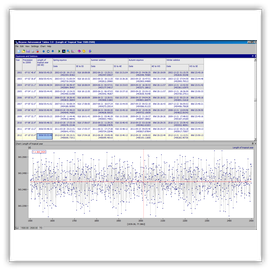
Planets in Perihelion, Aphelion, Nodes / Moon in Perigee, Apogee, Nodes
This table contains information on the perihelion, aphelion, and node passages of the planets and the perigee, apogee, and node passages of the Moon taking place from -2998 to 2999.
- The instant of the perihelion passage of the planet (perigee passage of the Moon) as a calendar date and/or a Julian day number expressed in dynamical time (TD) or universal time (UT).
- The longitudinal and latitudinal component of the heliocentric (geocentric) ecliptical / equatorial coordinates of the planet (Moon) at the time of perihelion (perigee) passage, referred to the mean equinox of the date or J2000.
- The heliocentric (geocentric) distance of the planet (Moon) at the time of perihelion (perigee) passage in astronomical units (or in kilometers or Earth radii in case of the Moon).
- The instant of the aphelion passage of the planet (apogee passage of the Moon) as a calendar date and/or a Julian day number expressed in dynamical time (TD) or universal time (UT).
- The longitudinal and latitudinal component of the heliocentric (geocentric) ecliptical / equatorial coordinates of the planet (Moon) at the time of aphelion (apogee) passage, referred to the mean equinox of the date or J2000.
- The heliocentric (geocentric) distance of the planet (Moon) at the time of aphelion (apogee) passage in astronomical units (or in kilometers or Earth radii in case of the Moon).
- The length of the anomalistic period (anomalistic month in case of the Moon) as the time difference between succeeding passages of the perihelion (perigee).
- The instant of the passage of the ascending node as a calendar date and/or a Julian day number expressed in dynamical time (TD) or universal time (UT).
- The longitudinal and latitudinal component of the heliocentric (geocentric) ecliptical / equatorial coordinates of the planet (Moon) at the time of passage of ascending node, referred to the mean equinox of the date or J2000.
- The heliocentric (geocentric) distance of the planet (Moon) at the time of passage of ascending node in astronomical units (or in kilometers or Earth radii in case of the Moon).
- The instant of the passage of the descending node as a calendar date and/or a Julian day number expressed in dynamical time (TD) or universal time (UT).
- The longitudinal and latitudinal component of the heliocentric (geocentric) ecliptical / equatorial coordinates of the planet (Moon) at the time of aphelion (apogee) passage, referred to the mean equinox of the date or J2000.
- The heliocentric (geocentric) distance of the planet (Moon) at the time of passage of descending node in astronomical units (or in kilometers or Earth radii in case of the Moon).
- The length of the draconic period (draconic month in case of the Moon) as the time difference between succeeding passages of the ascending node.

Conjunctions, Greatest Elongations, and Stations of the Inferior Planets
This table contains information on all (geocentric) superior/inferior conjunctions, greatest elongations and stations of Mercury and Venus taking place from -2998 to 2999.
- The instant of the superior conjunction of the planet with the Sun as a calendar date and/or a Julian day number expressed in dynamical time (TD) or universal time (UT).
- The longitudinal and latitudinal component of the geocentric ecliptical / equatorial coordinates of the planet at the time of superior conjunction, referred to the mean equinox of the date or J2000.
- The geocentric distance of the planet at the time of superior conjunction in astronomical units.
- The length of the (synodic) period as the time difference between succeeding superior conjunctions.
- The instant of the planet's greatest geocentric distance as a calendar date and/or a Julian day number expressed in dynamical time (TD) or universal time (UT).
- The longitudinal and latitudinal component of the geocentric ecliptical / equatorial coordinates of the planet at the time of it's greatest geocentric distance, referred to the mean equinox of the date or J2000.
- The geocentric distance of the planet at the time of it's greatest geocentric distance in astronomical units.
- The instant of the inferior conjunction of the planet with the Sun as a calendar date and/or a Julian day number expressed in dynamical time (TD) or universal time (UT).
- The longitudinal and latitudinal component of the geocentric ecliptical / equatorial coordinates of the planet at the time of inferior conjunction, referred to the mean equinox of the date or J2000.
- The geocentric distance of the planet at the time of inferior conjunction in astronomical units.
- The length of the (synodic) period as the time difference between succeeding inferior conjunctions.
- The instant of the planet's least geocentric distance as a calendar date and/or a Julian day number expressed in dynamical time (TD) or universal time (UT).
- The longitudinal and latitudinal component of the geocentric ecliptical coordinates of the planet at the time of it's least geocentric distance, referred to the mean equinox of the date or J2000.
- The geocentric distance of the planet at the time of it's least geocentric distance in astronomical units.
- The instant of greatest eastern elongation (evening visibility) of the planet of the planet as a calendar date and/or a Julian day number expressed in dynamical time (TD) or universal time (UT).
- The longitudinal and latitudinal component of the geocentric ecliptical / equatorial coordinates of the planet at the time of it's greatest eastern elongation, referred to the mean equinox of the date or J2000.
- The geocentric distance of the planet at the time of it's greatest eastern elongation in astronomical units.
- The greatest eastern elongation of the planet (the maximum angular separation between the center of the planet and the center of the Sun's disk) in degrees.
- The instant of greatest western elongation (morning visibility) of the planet of the planet as a calendar date and/or a Julian day number expressed in dynamical time (TD) or universal time (UT).
- The longitudinal and latitudinal component of the geocentric ecliptical / equatorial coordinates of the planet at the time of it's greatest western elongation, referred to the mean equinox of the date or J2000.
- The geocentric distance of the planet at the time of it's greatest western elongation in astronomical units.
- The greatest western elongation of the planet (the maximum angular separation between the center of the planet and the center of the Sun's disk) in degrees.
- The instant when the planet begins to move westward (retrograde, first station in celestial longitude) as a calendar date and/or a Julian day number expressed in dynamical time (TD) or universal time (UT).
- The time difference between the instant of first station in celestial longitude and the following inferior conjunction.
- The longitudinal and latitudinal component of the geocentric ecliptical / equatorial coordinates of the planet at the time of first station in celestial longitude, referred to the mean equinox of the date or J2000.
- The instant when the planet resums direct motion (eastward, second station in celestial longitude) as a calendar date and/or a Julian day number expressed in dynamical time (TD) or universal time (UT).
- The time difference between the instant of second station in celestial longitude and the preceeding inferior conjunction.
- The longitudinal and latitudinal component of the geocentric ecliptical / equatorial coordinates of the planet at the time of second station in celestial longitude, referred to the mean equinox of the date or J2000.

Conjunctions, Oppositions, and Stations of the Superior Planets
This table contains information on all (geocentric) conjunctions, oppositions and stations of Mars, Jupiter, Saturn, Uranus, and Neptune taking place from -2998 (1700 for Uranus and Neptune) to 2999.
- The instant of the conjunction of the planet with the Sun as a calendar date and/or a Julian day number expressed in dynamical time (TD) or universal time (UT).
- The longitudinal and latitudinal component of the geocentric ecliptical / equatorial coordinates of the planet at the time of conjunction, referred to the mean equinox of the date or J2000.
- The geocentric distance of the planet at the time of conjunction in astronomical units.
- The length of the (synodic) period as the time difference between succeeding conjunctions of the planet with the Sun.
- The instant of the planet's greatest geocentric distance as a calendar date and/or a Julian day number expressed in dynamical time (TD) or universal time (UT).
- The longitudinal and latitudinal component of the geocentric ecliptical / equatorial coordinates of the planet at the time of it's greatest geocentric distance, referred to the mean equinox of the date or J2000.
- The geocentric distance of the planet at the time of it's greatest geocentric distance in astronomical units.
- The instant of the opposition of the planet as a calendar date and/or a Julian day number expressed in dynamical time (TD) or universal time (UT).
- The longitudinal and latitudinal component of the geocentric ecliptical / equatorial coordinates of the planet at the time of opposition, referred to the mean equinox of the date or J2000.
- The geocentric distance of the planet at the time of opposition in astronomical units.
- The visual magnitude of the planet at the time of opposition.
- The length of the (synodic) period as the time difference between succeeding oppositions.
- The instant of the planet's least geocentric distance as a calendar date and/or a Julian day number expressed in dynamical time (TD) or universal time (UT).
- The longitudinal and latitudinal component of the geocentric ecliptical / equatorial coordinates of the planet at the time of it's least geocentric distance, referred to the mean equinox of the date or J2000.
- The geocentric distance of the planet at the time of it's least geocentric distance in astronomical units.
- The visual magnitude of the planet at the time of it's least geocentric distance.
- The instant when the planet begins to move westward (retrograde, first station in celestial longitude) as a calendar date and/or a Julian day number expressed in dynamical time (TD) or universal time (UT).
- The time difference between the instant of first station in celestial longitude and the following inferior conjunction.
- The longitudinal and latitudinal component of the geocentric ecliptical / equatorial coordinates of the planet at the time of first station in celestial longitude, referred to the mean equinox of the date or J2000.
- The instant when the planet resums direct motion (eastward, second station in celestial longitude) as a calendar date and/or a Julian day number expressed in dynamical time (TD) or universal time (UT).
- The time difference between the instant of second station in celestial longitude and the preceeding inferior conjunction.
- The longitudinal and latitudinal component of the geocentric ecliptical / equatorial coordinates of the planet at the time of second station in celestial longitude, referred to the mean equinox of the date or J2000.

Phases of the Moon
This table contains information on the instants of the phases of the Moon for the years -2998 to 2999. These are the instants when the difference between the apparent longitudes of the Moon and the Sun (corrected for the effects of aberration and nutation) is 0° (New Moon; conjunction) or 180° (Full Moon; opposition).
- The lunation number (number of synodic moons since New Moon of 2000-01-06).
- The instant of New Moon (geocentric conjunction of the Moon with the Sun) as a calendar date and/or a Julian day number expressed in dynamical time (TD) or universal time (UT).
- The longitudinal and latitudinal component of the geocentric ecliptical / equatorial coordinates of the planet at the time of New Moon, referred to the mean equinox of the date or J2000.
- The geocentric distance of the Moon at the time of New Moon in astronomical units, kilometers or Earth radii).
- The instant of Full Moon (geocentric opposition) as a calendar date and/or a Julian day number expressed in dynamical time (TD) or universal time (UT).
- The longitudinal and latitudinal component of the geocentric ecliptical / equatorial coordinates of the planet at the time of Full Moon, referred to the mean equinox of the date or J2000.
- The geocentric distance of the Moon at the time of New Moon in astronomical units, kilometers or Earth radii).
- The length of the lunar synodic period as the time difference between succeeding conjunctions of the Moon with the Sun (New Moons).

Five Millennium Canon of Solar Eclipses
This table contains information on all solar eclipses taking place from -1999 to +3000. All eclipse predictions were performed by Fred Espenak and Jean Meeus ( NASA's GSFC). For each eclipse the following data are given:
- The sequential number of the eclipse in the Five Millennium Canon of Solar Eclipses.
- The instant of greatest eclipse (the instant when the axis of the Moon's shadow cone passes closest to Earth's center) as a calendar date and/or a Julian day number expressed in dynamical time (TD) or universal time (UT), depending on the Settings.
- DT = TD - UT is the difference between dynamical (ephemeris) time (TD) and universal time (UT), used for the calculation of location of greatest eclipse (see below).
- The lunation number (number of synodic moons since New Moon of 2000-01-06).
- The Saros series number of eclipse.
- The type of eclipse (total, annular, hybrid, partial).
- Eclipse magnitude (fraction of the Sun's diameter obscured by the Moon). For annular, total, and hybrid eclipses this value is actually the diameter ration of Moon/Sun.
- Distance of the shadow cone axis from the centerof Earth (in units of equatorial Earth radii) at the instant of greatest eclipse.
- Geographic position (latitude and longitude) where greatest eclipse is seen. Note that this value strongly depends on the determination of delta T (selected in delta T dialog). In the Five Millennium Canon of Solar Eclipses delta T is determined by the formulas given by Morrison and Stepenson (2004).
- Sun's azimuth and altitude at greatest eclipse.
- Width of the path of totality or annularity at greatest eclipse in kilometers.
- Central line duration of total or annular phase at greatest eclipse.
- Remark(s) on the solar eclipse
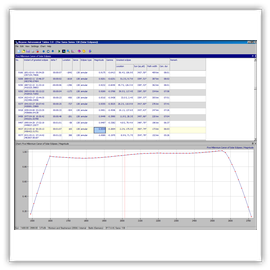
Five Millennium Canon of Lunar Eclipses
This table contains information on all lunar eclipses taking place from -1999 to +3000. All eclipse predictions were performed by Fred Espenak and Jean Meeus ( NASA's GSFC). For each eclipse the following data are given:
- The sequential number of the eclipse in the Five Millennium Canon of Lunar Eclipses.
- The instant of greatest eclipse (the instant when the distance between the center of the Moon and the axis or Earth's umbral shadow cone reaches a minimum) as a calendar date and/or a Julian day number expressed in dynamical time (TD) or universal time (UT), depending on the Settings.
- DT = TD - UT is the difference between dynamical (ephemeris) time (TD) and universal time (UT), used for the calculation of location of greatest eclipse (see below).
- The lunation number (number of synodic moons since New Moon of 2000-01-06).
- The Saros series number of eclipse.
- The type of eclipse (total, partial, penumbral).
- Distance from the center of the shadow cone axis to the center of the Moon (in units of Earth's equatorial radii) at the instant of greatest eclipse.
- Penumbral magnitude (fraction of the Moon's diameter immersed in the penumbra at the instant of greatest eclipse).
- Umbral magnitude (fraction of the Moon's diameter immersed in the penumbra at the instant of greatest eclipse).
- Duration of penumbral phase of a lunar eclipse (in minutes); equal to the time interval between first and last contact of the Moon with the penumbral shadow (= P4 - P1).
- Duration of partial phase of a lunar eclipse (in minutes); equal to the time interval between first and last contact of the Moon with the umbral shadow (= U4 - U1).
- Duration of total phase of a lunar eclipse (in minutes); equal to the time interval between second and third contact of the Moon with the umbral shadow (= U3 - U2).
- Geographic position (latitude and longitude) where the Moon appears in the zenith at instant of greatest eclipse. Note that this value strongly depends on the determination of delta T (selected in delta T dialog). In the Five Millennium Canon of Solar Eclipses delta T is determined by the formulas given by Morrison and Stepenson (2004).
- Remark(s) on the lunar eclipse
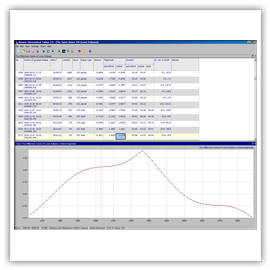
Local Circumstances of Solar Eclipses
This table contains information on local circumstances (for current location) of all solar eclipses taking place from -1999 to +3000.
- The calendar date of the solar eclipse.
- The lunation number (number of synodic moons since New Moon of 2000-01-06).
- The Saros series number of eclipse.
- DT = TD - UT, the difference between dynamical (ephemeris) time (TD) and universal time (UT), used for the calculation of the local circumstances of the eclipse.
- Maximum magnitude of the eclipse (fraction of the Sun's diameter obscured by the Moon) at the place of observation.
- The type of eclipse (total, annular, hybrid, partial) at the place of observation.
- The time of first contact (T1 - begin of partial phase)
- The altitude of the Sun, corrected for the effect of refraction, at the instant of first contact.
- In the case of total or annular eclipses the time of second contact (T2 - the time of beginning of the total or annular phase).
- The altitude of the Sun, corrected for the effect of refraction, at the instant of second contact.
- The time of maximum ecipse.
- The altitude of the Sun, corrected for the effect of refraction, at the instant of maximum eclipse (least angular distance between the centers of Moon and Sun, as seen from the given place of observation).
- In the case of total or annular eclipses the time of third contact (T3 - the time of end of the total or annular phase).
- The altitude of the Sun, corrected for the effect of refraction, at the instant of third contact.
- The time of fourth (last) contact (T4 - end of partial phase)
- The altitude of the Sun, corrected for the effect of refraction, at the instant of last contact.
- The duration of the eclipse at the place of observation (T4-T1).
- The duration of the total or annular phase of the eclipse at the place of observation (T3-T2).

Local Circumstances of Lunar Eclipses
This table contains information on local circumstances (for current location) of all lunar eclipses taking place from -1999 to +3000.
- The calendar date of the lunar eclipse.
- The lunation number (number of synodic moons since New Moon of 2000-01-06).
- The Saros series number of eclipse.
- DT = TD - UT, the difference between dynamical (ephemeris) time (TD) and universal time (UT), used for the calculation of the local circumstances of the eclipse.
- Maximum magnitude of the penumbra of the eclipse (fraction of the Moon's diameter immersed in the penumbra at the instant of greatest eclipse) at the place of observation.
- Maximum magnitude of the umbra of the eclipse (fraction of the Moon's diameter immersed in the umbra at the instant of greatest eclipse) at the place of observation. Note that the umbral magnitude is negative in the case of penumbral eclipses.
- The type of eclipse (total, partial, penumbral) at the place of observation.
- The time of beginning of the penumbral phase (P1 - instant of first exterior tangency of the Moon with the penumbra).
- The altitude of the Moon, corrected for the effect of refraction, at the instant of beginning of the penumbral phase.
- The time of beginning of the umbral phase (U1 - instant of first exterior tangency of the Moon with the umbra) (partial and total eclipses only),
- The altitude of the Moon, corrected for the effect of refraction, at the instant of beginning of the umbral phase.
- The time of beginning of the total phase (U2 - instant of first interior tangency of the Moon with the umbra) .
- The altitude of the Moon, corrected for the effect of refraction, at the beginning of total phase.
- The time of maximum eclipse.
- The altitude of the Moon, corrected for the effect of refraction, at the instant of maximum eclipse.
- The time of end of the total phase (U3 - instant of last interior tangency of the Moon with the umbra).
- The altitude of the Moon, corrected for the effect of refraction, at the instant of end of total phase.
- The time of end of the umbral phase (U4 - instant of last exterior tangency of the Moon with the umbra) (partial and total eclipses only),
- The altitude of the Moon, corrected for the effect of refraction, at the end of total phase.
- The time of end of the penumbral phase (P4 - instant of last exterior tangency of the Moon with the penumbra).
- The altitude of the Moon, corrected for the effect of refraction, at the instant of end of the penumbral phase.
- The duration of the eclipse at the place of observation (P4-P1).
- The duration of the partial phse of the eclipse at the place of observation (U4-U1).
- The duration of the total phse of the eclipse at the place of observation (U3-U2).
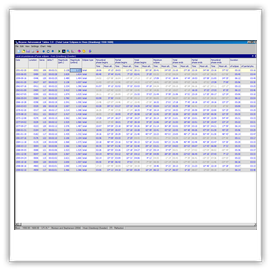
Transits of Mercury and Venus, geocentric phase
This table contains information on the geocentric phases of the transits of Mercury and Venus taking place from 1605 to 2295 (Mercury) resp. -1998 to 2984 (Venus).
- The calendar date of transit.
- The time of exterior contact at ingress.
- The geocentric position angle of the center of the planet's disk at the time of exterior contact at ingress (measured from the North Point of the solar disk eastward).
- The time of interior contact at ingress.
- The geocentric position angle of the center of the planet's disk at the time of interior contact at ingress (measured from the North Point of the solar disk eastward).
- The time of the least angular distance between the centers of the planet an the Sun.
- The least angular distance (in seconds of arc) during the transit between the centers of the planet an the Sun.
- The time of interior contact at egress.
- The geocentric position angle of the center of the planet's disk at the time interior contact at egress (measured from the North Point of the solar disk eastward).
- The time of exterior contact at egress.
- The geocentric position angle of the center of the planet's disk at the time of interior contact at egress (measured from the North Point of the solar disk eastward).
- The semidiameter of the Sun, in arcsec, at the time of least angular distance.
- The semidiameter of the planet (Mercury, Venus), in arcsec, at the time of least angular distance.
- The transit series.

Transits of Mercury and Venus, local circumstances
This table contains information on local circumstances (for current location) of the transits of Mercury and Venus taking place from 1605 to 2295 (Mercury) resp. -1998 to 2984 (Venus).
- The calendar date of transit.
- DT = TD - UT, the difference between dynamical (ephemeris) time (TD) and universal time (UT), used for the calculation of the local circumstances of the transit.
- The time of exterior contact at ingress.
- The altitude of the Sun, corrected for the effect of refraction, at the place of observation at the time of exterior contact at ingress.
- The time of interior contact at ingress.
- The altitude of the Sun, corrected for the effect of refraction, at the place of observation at the time of interior contact at ingress.
- The time of the least angular distance between the centers of the planet an the Sun.
- The altitude of the Sun, corrected for the effect of refraction, at the place of observation at the time of least angular distance between the centers of the planet an the Sun.
- The least angular distance (in seconds of arc) during the transit between the centers of the planet an the Sun.
- The time of interior contact at egress.
- The altitude of the Sun, corrected for the effect of refraction, at the place of observation at the time of interior contact at egress.
- The time of exterior contact at egress.
- The altitude of the Sun, corrected for the effect of refraction, at the place of observation at the time of exterior contact at egress.
- The semidiameter of the Sun, in arcsec, at the time of least angular distance.
- The semidiameter of the planet (Mercury, Venus), in arcsec, at the time of least angular distance.
- The transit series.
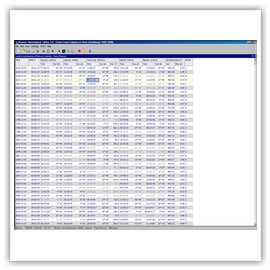
Times of Rise, Culmination, and Set
This table contains information on the times of rise, culmination, and set for the Sun, Moon, and planets (for current location). The computation of the times incorporates a model that determines the angular refraction by numerically integrating a ray passing through a simple polytropic atmosphere (see Refraction for more information). The rise and set times are given for a geometric horizon (the horizon dip is not taken into account).
- The rise time of the selected body.
- The azimuth of the selected body at rise time.
- The altitude of the Sun, corrected for the effect of refraction, at the rise time of the selected body.
- The lunar phase at rise time [Moon only].
- The culmination time of the selected body (the time when the body is at its greatest altitude). Note that the greatest altitude coincides not with the meridian passage.
- The culmination altitude of the object, corrected for the effect of refraction.
- The altitude of the Sun, corrected for the effect of refraction, at the culmination time of the selected body.
- The lunar phase at culmination time [Moon only].
- The set time of the selected body.
- The azimuth of the selected body at set time.
- The altitude of the Sun, corrected for the effect of refraction, at the set time of the selected body.
- The lunar phase at set time [Moon only].
- The time difference between set time and preceeding rise time (body above horizon).
- The visual magnitude of the planet at 12:00 of the given day [Planets only].
